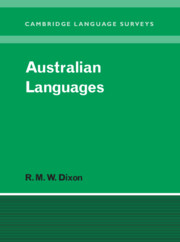Book contents
- Frontmatter
- Contents
- List of maps
- List of abbreviations and conventions
- Preface
- Acknowledgements
- Conventions followed
- List of languages and language groups
- 1 The language situation in Australia
- 2 Modelling the language situation
- 3 Overview
- 4 Vocabulary
- 5 Case and other nominal suffixes
- 6 Verbs
- 7 Pronouns
- 8 Bound pronouns
- 9 Prefixing and fusion
- 10 Generic nouns, classifiers, genders and noun classes
- 11 Ergative/accusative morphological and syntactic profiles
- 12 Phonology
- 13 Genetic subgroups and small linguistic areas
- 14 Summary and conclusion
- References
- Index of languages, dialects and language groups
- Subject index
2 - Modelling the language situation
Published online by Cambridge University Press: 22 September 2009
- Frontmatter
- Contents
- List of maps
- List of abbreviations and conventions
- Preface
- Acknowledgements
- Conventions followed
- List of languages and language groups
- 1 The language situation in Australia
- 2 Modelling the language situation
- 3 Overview
- 4 Vocabulary
- 5 Case and other nominal suffixes
- 6 Verbs
- 7 Pronouns
- 8 Bound pronouns
- 9 Prefixing and fusion
- 10 Generic nouns, classifiers, genders and noun classes
- 11 Ergative/accusative morphological and syntactic profiles
- 12 Phonology
- 13 Genetic subgroups and small linguistic areas
- 14 Summary and conclusion
- References
- Index of languages, dialects and language groups
- Subject index
Summary
This chapter outlines the methodological basis for those that follow. A large part of it summarises points from The rise and fall of languages (Dixon 1997) with a few sections being taken verbatim from that essay. For a fuller discussion the reader is referred to Rise and fall.
§2.1.1 lists the assumptions underlying this work, §2.1.2 discusses kinds of explanation for similarities between languages, and §2.1.3 assesses the applicability of the family tree model. §2.1.4 deals with different kinds of linguistic diffusion – phonetic and phonological; grammatical categories, construction types and techniques; grammatical forms; and lexemes. Then §2.1.5 explains how the ‘50 per cent equilibrium level’ of vocabulary similarity typically applies, in the Australian linguistic area, for languages which have been in contiguity for a considerable period of time.
§2.2 explains the Punctuated Equilibrium model. §2.3 deals with the language situation in Australia, New Guinea and Tasmania, which were one land mass for most of the time that languages have been spoken in this part of the world, and puts forward a tentative scenario for the development of the Australian language situation. Then §2.4.1 briefly mentions social conditions for languages to split, and §2.4.2 enquires whether it is possible for two languages to merge. The appendix deals with lexicostatistics and the ‘Pama-Nyungan’ hypothesis.
Preliminaries
Assumptions
In any scientific endeavour it is appropriate to set out the principles which are followed.
- Type
- Chapter
- Information
- Australian LanguagesTheir Nature and Development, pp. 20 - 54Publisher: Cambridge University PressPrint publication year: 2002

